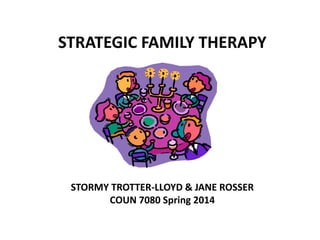Rosser Sft slidshare
- 1. STRATEGIC FAMILY THERAPY STORMY TROTTER-LLOYD & JANE ROSSER COUN 7080 Spring 2014
- 2. Strategic Family Therapy Haley called the therapy ‘Strategic’ because: "it is a therapy where the therapist initiates what happens during therapy, designs a specific approach for each person's presenting problem, and where the therapist takes responsibility for directly influencing people." http://www.mri.org/strategic_family_therapy.html Roots in structural family therapy Builds on concepts from communication theory
- 3. LEADING FIGURES Palo Alto Group 1960-70’s Brief Family Therapy /Mental Research Institute (MRI) Don Jackson, Gregory Bateson, John Weakland, Paul Watzlawick (family communication) Strategic Family Therapy Institute 1980’s Jay Haley & Cloe Madanes (directive & challenging) Milan Systemic Model Mara Selvini-Palazzoli (
- 5. ÔÇß How VERBAL and NONVERBAL messages are exchanged ÔÇß PROCESS between people in a SYSTEM vs. inner conflicts ÔÇß WHAT rather than WHY ÔÇß Communication PATTERNS vs. content ÔÇß Faulty communication patterns = family DYSFUNCTION
- 6. INTERPERSONAL NATURE OF COMMUNICATION  All behavior is communication  Communication happens at many levels  Every communication has a content(report) & a relationship(command) aspect  Relationships are defined by command messages  Complementary interactive patterns = oppositional create superior/inferior relationships  Symmetrical interactive pattern = equality – can become competitive  Each person punctuates a sequence of events in different ways organizing their view of cause and effect
- 7. Focus IP symptoms Family attempts to address “problem” behavior Actions become a pattern Pattern reinforces IP behaviors Circular Patterns
- 8. Breakdown in family functions … Solutions become part of the problem … Contradictions between what is said and what is expressed… Breakdown in rules and roles… Repeating non-workable solutions …
- 10. What does Strategic Family Therapy look like? Active Brief Directive Therapist Centered Task Oriented
- 11. Define the problem Identify attempted solutions Determine the position of the client Designing an intervention Selling the client on the intervention Assigning homework Doing a homework follow-up Terminating Latino Brief Therapy Center (Schlanger & Anger-Diaz (1999)
- 12. KEY CONCEPTS PARADOXICAL INJUNCTIONS – Contradictions between what is said and what is expressed in tone or gesture PARADOXICAL DIRECTIVES – Direct client to continue or extend the behavior. Non-confrontational – undermines resistance – ties in to patients own momentum DOUBLE BIND – Conflicting messages – can’t win situations THERAPEUTIC DOUBLE BIND (COUNTER PARADOXES) – Technique to force a person/couple/family into a no-lose situation PRESCRIBING THE SYMPTOM – prescribe the very behavior to be resolved. The therapist helps the client understand this need and determine how much control they have over the symptom. This can help them change or stop it. RELABELING (POSITIVE CONNOTATION) – Changing the label attached to a person or problem from negative to positive. In altering the meaning, the emotional and conceptual context, the situation can be perceived differently, and hopefully new responses will evolve.
- 13. KEY CONCEPTS FIRST ORDER CHANGES – superficial behavioral changes within a system that do not change the structure of the system SECOND ORDER CHANGES – changes to the systemic interaction pattern so the system is reorganized and functions more effectively FAMILY HOMEOSTASIS – families tend to preserve familiar organization and communication patterns – resistant to change FAULTY FAMILY SOLUTIONS 1) Ignoring a problem when action is needed 2) Taking action when it is unnecessary 3) Action taken at the wrong level i.e. first order changes when the problem is at a second order level DIRECTIVES - Challenging Provoke – rebel or resist Ordeal Therapy – undesirable task – more difficult for the client to have the problem than give it up
- 14. KEY CONCEPTS PRETEND TECHNIQUES – Encourage family members to ‘pretend’ – playfulness and fantasy – shift context – encourage voluntary control of behavior HYPOTHESIZING – interactive process of speculating = determine how the family is organized around the problem NEUTRALITY - Remain allied with all family members – avoid coalitions or alliances CIRCULAR QUESTIONING – focusing on family connections rather than individual family members to address family differences REFLEXIVE QUESTIONING (Tomm – social constructionist/narrative) Help families reflect on perceptions, actions, & belief systems – meaning of their life patterns Types of Questions: Future oriented questions Observer - perspective Unexpected counterchange Embedded suggestion Normative- comparison Distinction-clarifying Questions introducing hypotheses Process interrupting
- 15. Want to read more …. there are some great resources on line that illustrate the theory and applications………… Robbins, M. S., Szapocznik, J., & United States. (2000). Brief strategic family therapy. Washington, DC: U.S. Dept. of Justice, Office of Justice Programs, Office of Juvenile Justice and Delinquency Prevention.















